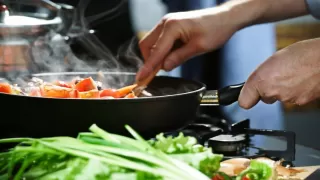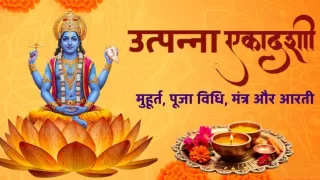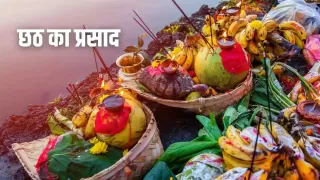Diwali, the festival of lights, is incomplete without an array of traditional Indian sweets. Each region of India brings its own unique flavours and textures to the festive table, making Diwali a culinary celebration that delights both the eyes and the taste buds. From melt-in-your-mouth ladoos to syrupy jalebis, these sweets are more than just desserts, they’re a symbol of joy, prosperity, and togetherness.
Here, we explore the top 5 famous Indian sweets you absolutely must try this Diwali. We not only dive into their flavours and textures but also share preparation tips, history, and interesting nuances that make each sweet a standout. Whether you are a seasoned cook or a beginner in the kitchen, this guide will help you bring the authentic taste of Diwali into your home.
5. Gulab Jamun
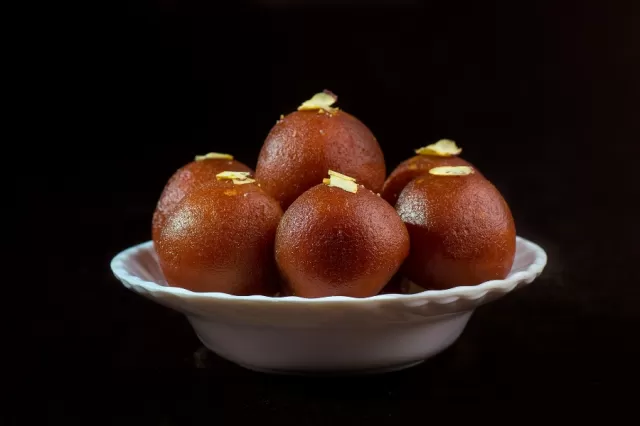
If indulgence had a name, it would be Gulab Jamun. Soft, spongy, and soaked in rose-scented sugar syrup, gulab jamun is a dessert that embodies decadence. It’s a staple at Diwali feasts, weddings, and celebrations across India, often garnished with slivers of pistachio or almond.
The unique charm of gulab jamun lies in its texture, light and airy, yet luxuriously sweet. Each bite releases the subtle fragrance of rose water and cardamom, perfectly balancing richness with delicate floral notes.
How to Prepare Gulab Jamun
- Combine khoya (reduced milk solids), all-purpose flour, and a pinch of baking soda to form a soft dough.
- Roll the dough into smooth, crack-free balls. Cracks can prevent proper syrup absorption.
- Deep-fry on low to medium heat until golden-brown. Patience is key; high heat can cook the exterior too quickly and leave the inside raw.
- Transfer immediately into warm sugar syrup infused with rose water and cardamom. Soak for at least 2 hours before serving.
- If the dough is sticky, dust your hands lightly with flour. Avoid adding excess flour to prevent dense gulab jamuns.
Gulab jamun is a crowd-pleaser, transcending age and region. Its richness and floral aroma make it the centrepiece of Diwali sweet platters. Serving it warm enhances the sensory experience, making it a perfect end to a festive meal.
4. Kaju Katli
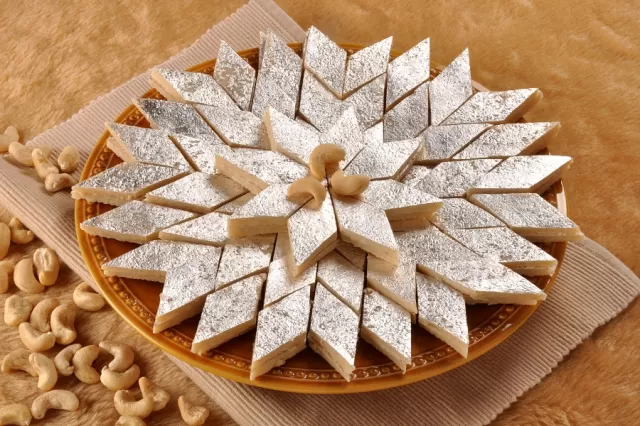
Kaju Katli, a cashew-based fudge, is synonymous with elegance and sophistication in Indian sweets. Its smooth, melt-in-the-mouth texture and subtle sweetness make it a favourite for gifting during Diwali. Traditionally cut into diamond shapes and decorated with edible silver leaf, kaju katli is visually as delightful as it is delicious.
Originating from royal kitchens, kaju katli carries a rich cultural history. It’s associated with celebrations, prosperity, and the joy of giving. Each bite reveals the creamy essence of cashews and a delicate sweetness that never overwhelms the palate.
How to Prepare Kaju Katli
- Pulse cashews in a food processor until powdery, being careful not to turn them into a paste.
- Cook sugar on low flame until it reaches the one-string stage.
- Fold the cashew powder into the syrup off the heat, mixing gently to form a non-sticky dough.
- Roll the dough between parchment sheets to ¼-inch thickness.
- Cut into diamond shapes and apply edible silver foil if desired.
Over-processing cashews releases oils and affects texture, so attention to detail is crucial. Kaju katli embodies luxury in a bite and remains a top choice for those seeking a refined sweet during Diwali. Pairing it with dry fruits or gifting it in decorative boxes elevates its charm further.
3. Jalebi
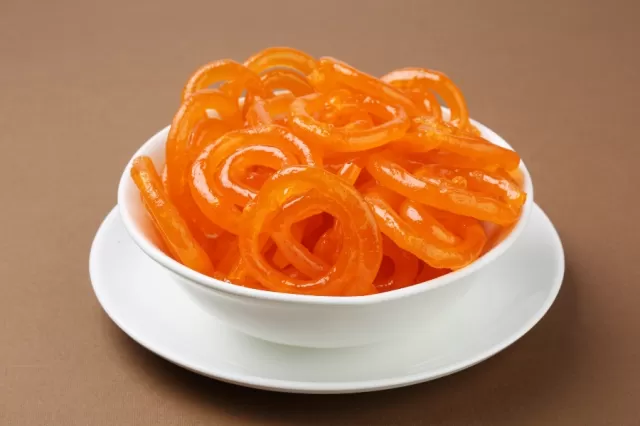
No Diwali celebration is complete without Jalebi. This bright orange, coiled sweet is crispy on the outside, syrupy within, and visually irresistible. Freshly fried jalebis glisten in syrup, offering a tangy-sweet flavour and a satisfying crunch that softens as you bite in.
Jalebi’s origins trace back to the Middle East, but it has been embraced as a quintessential Indian dessert. It’s commonly served with rabri (thickened sweetened milk), creating a perfect balance of textures and flavours. The instant gratification of biting into hot jalebi is unmatched, making it a favorite for both young and old.
How to Prepare Jalebi
- Whisk flour, yoghurt, and a pinch of turmeric into a smooth batter and let it ferment overnight.
- Heat oil to 175°C (350°F).
- Pipe batter through a squeeze bottle or piping bag into spiral shapes directly into hot oil.
- Fry until crisp, then briefly drain and soak in warm sugar syrup for 30 seconds.
- Serve immediately, optionally paired with rabri for a creamy complement.
The key to perfect jalebi is timing. Frying at the right temperature ensures a crunchy exterior, while soaking briefly in syrup keeps the inside soft and sweet. Jalebi is often a crowd favourite at Diwali markets and family gatherings, providing both nostalgia and instant delight.
2. Rasgulla
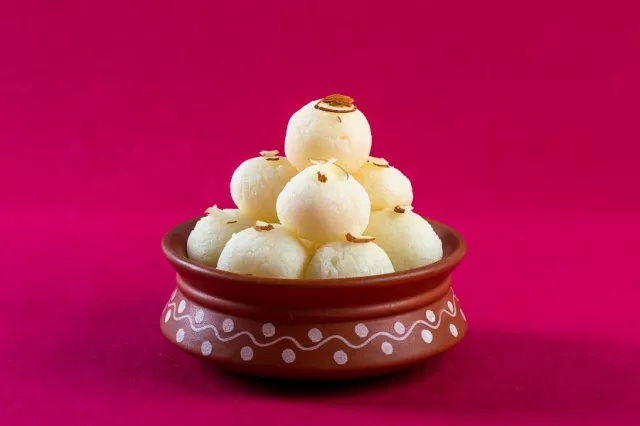
Rasgulla, originating from Bengal, has earned pan-Indian love for its light, airy texture and clean, syrupy sweetness. Unlike heavier sweets, rasgulla offers a refreshing counterpoint, making it an ideal addition to Diwali platters. Soft, spongy, and mildly sweet, each ball expands in syrup, creating a delicate bite that melts in the mouth.
Rasgulla is often associated with Bengali festivals and celebrations, but it has seamlessly integrated into Diwali traditions across India. Its simplicity and elegance make it a versatile dessert, suitable for both gifting and serving at family feasts.
How to Prepare Rasgulla
- Curdle whole milk with lemon juice and drain the chenna. Rinse under cold water to remove acidity.
- Knead the chenna on a flat surface for 8–10 minutes until smooth.
- Roll into small, crack-free balls. Avoid cracks to prevent disintegration during boiling.
- Boil in sugar-water syrup over medium heat for 15–20 minutes. The balls will expand and absorb syrup.
- Cool in syrup and refrigerate for at least 2 hours before serving.
Proper kneading is crucial. Under-kneaded chenna results in dense, rubbery rasgullas, while over-kneaded chenna may release too much moisture and disintegrate. Mastering this balance ensures perfect spongy balls every time.
Rasgulla’s lightness makes it a perfect complement to heavier Diwali sweets. Its refreshing taste cleanses the palate and adds variety to the festive table. Serving rasgullas chilled enhances their texture and flavor, making them a delightful treat for guests.
1. Ladoo (Motichoor, Besan, Coconut)
Ladoo is arguably the most iconic sweet of Diwali. Its round shape is symbolic of completeness and prosperity, making it a favorite for festive gifting and rituals. There are several varieties, each offering a distinct flavour and texture.
- Motichoor Ladoo: Tiny boondi droplets are fried to perfection and soaked in warm sugar syrup before being shaped into delicate balls. The texture is grainy yet melts in the mouth, and the subtle cardamom flavor makes it irresistible.
- Besan Ladoo: Roasted gram flour and ghee come together to create a smooth, nutty aroma. Sweetened with sugar syrup, these ladoos are a fragrant delight that carries the warmth of traditional kitchens.
- Coconut Ladoo: Soft, chewy, and fragrant with cardamom, coconut ladoos are an indulgent treat that balances sweetness with the tropical aroma of coconut.
How to Prepare Ladoo
Motichoor: Fry tiny boondi droplets in ghee until golden. Soak them in warm sugar syrup for 5-10 minutes, then shape into balls while still warm.
Besan: Roast gram flour in ghee until fragrant, mix with sugar syrup, and roll into smooth spheres. Let them cool slightly to retain shape.
Coconut: Toast grated coconut lightly, mix with condensed milk and cardamom powder, and shape into balls while warm. Refrigerate briefly to firm up if needed.
Ladoo is more than just a sweet; it’s an experience. The aroma of roasting flour and ghee fills the kitchen, the warm sweetness lingers on the tongue, and every bite evokes memories of family gatherings and Diwali festivities. Offering ladoos to guests or gifting them in decorative boxes is a gesture of love and tradition.
Also Read: Best 10 Family Vacation Spots in India for Diwali 2025







